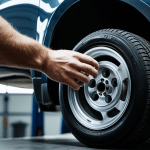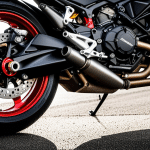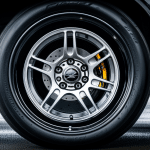Understanding Tire Pressure and Heat Impact
Maintaining tire pressure is crucial for vehicle safety, especially for lightweight vehicles. High temperatures can significantly affect tire pressure, making it a vital aspect of vehicle maintenance during heatwaves. When temperatures rise, the air inside tires expands, increasing pressure. This phenomenon, known as the heat impact, can lead to overinflation if not monitored correctly. Conversely, as temperatures drop, tire pressure decreases, which can cause underinflation.
Keeping tire pressure within recommended limits ensures the optimal performance and lifespan of tires. Lightweight vehicles are particularly susceptible to pressure changes, as they can affect handling and fuel efficiency. Consequently, maintaining proper tire pressure becomes indispensable for both safety and performance.
A découvrir également : Traveling with Pets: Key Safety Tips to Keep Your Eyes on the Road
Incorrect tire pressure during heatwaves can have severe consequences. Overinflated tires may lead to reduced traction and an uncomfortable ride, while underinflated tires can suffer from increased rolling resistance, elevating the risk of blowouts. Consistent monitoring and adjustment of tire pressure according to environmental conditions are imperative measures to ensure road safety and prevent potential accidents. Understanding and managing these aspects are integral for drivers when navigating variable temperature conditions.
Measuring Tire Pressure Accurately
Accurate tire pressure measurement is essential for maintaining vehicle safety. Employing the right tools, such as an accurate tire pressure gauge, can make all the difference.
Lire également : Comprehensive Guide to Tracking Taxi Tire Wear: Prioritizing Passenger Safety Above All
Required Tools
To measure tire pressure effectively, a tire pressure gauge is indispensable. Options range from traditional stick gauges to digital and dial versions. Each gauge type offers varying degrees of accuracy, with digital gauges generally providing the most precise readings.
Step-by-Step Measuring Process
Begin by ensuring the tires are cold, as heat can affect accuracy. Remove the valve cap and press the gauge onto the valve stem. The gauge will display the current pressure, which should be compared against the vehicle’s manufacturer recommendations found in the owner’s manual or the driver-side door placard.
Common Mistakes
Common errors, such as failing to measure when tires are cold, can lead to inaccurate readings. Avoiding these pitfalls ensures reliable measurements. Another frequent mistake is cross-referencing the wrong PSI standards; always use the manufacturer’s specifications for your particular vehicle.
By understanding these aspects, drivers can maintain their vehicles’ performance and enhance safety through precise tire pressure management.
Adjusting Tire Pressure for Heat
Managing tire pressure adjustment during a heatwave is essential for vehicle safety. As temperatures rise, it may be advisable to adjust tire pressure to accommodate the intensified conditions.
Heatwave Recommendations
During a UK heatwave, increasing tire pressure slightly can be beneficial. This counteracts expansion due to high temperatures, ensuring that your tires do not become overly inflated. Carefully follow manufacturer recommendations for any adjustments, as they are specifically tailored for your vehicle’s needs.
Inflation Guidelines
When adjusting tire pressure, it is crucial to do so responsibly. Over-inflating can result in reduced traction and potential safety hazards. Therefore, adhere to recommended limits and regularly check tire pressure to prevent dangerous misjudgments. Remember, maintaining proper tire inflation levels not only aids in safety but also extends tire lifespan.
Manufacturer Recommendations
Following the manufacturer’s recommendations for tire pressure adjustments is vital. These guidelines are crafted to optimize performance and safety, providing valuable insights for adapting to fluctuating temperatures. Regular consultation of these recommendations ensures that your vehicle maintains its integrity no matter the climate conditions.
Safety Precautions and Best Practices
Ensuring vehicle safety involves both correct tire pressure and thorough tire maintenance. Following safety precautions is critical, particularly during extreme heat, to mitigate any vehicle risks.
Checking Tire Condition
Regularly inspecting tires is crucial during high temperatures. Heat can exacerbate existing damage, leading to potential failures. Look for indicators like cracks, bulges, or excessive tread wear. Each of these can signify heat-related deterioration, threatening both vehicle safety and performance.
Safety Protocols Post-Adjustment
After making any tire pressure adjustments, it’s imperative to monitor the tires closely. Ensure that your vehicle’s handling and ride remain consistent with expectations. If you notice any changes, re-check the tire pressure and examine for any anomalies. Regular performance checks can help you identify and troubleshoot potential issues promptly, fortifying your safety protocols.
Regulatory Compliance in the UK
In the UK, regulatory compliance ensures that vehicle maintenance standards are met. Vehicle owners must adhere to legal responsibilities regarding tire condition and pressure. Regular checks can prevent compliance breaches, which may lead to fines or other penalties. Maintaining your vehicle according to these regulations not only ensures safety but also helps you avoid legal repercussions.
Maintaining Tire Pressure Beyond the Heatwave
Proper tire maintenance is vital for vehicle longevity and safety, extending well beyond the heatwave season. Consistent tire pressure checks prevent issues that might not immediately become apparent. During varying seasons, fluctuating temperatures can cause pressure imbalances, necessitating continuous monitoring.
Seasonal Adjustments
Seasonal adjustments are crucial for maintaining optimal tire performance. When temperatures shift, air density changes, impacting tire pressure. For instance, colder weather might cause tires to lose pressure, requiring adjustments. Consistent checks ensure tires are within recommended limits, providing better handling and stability.
Benefits of Regular Maintenance
Maintaining tire pressure is more than a safety measure; it’s a strategic approach to enhancing vehicle performance. Regular tire maintenance helps identify potential problems like air leaks or valve stem issues before they worsen. Such practices result in improved fuel efficiency and reduced tire wear. Maintaining the correct pressure reduces rolling resistance, which enhances fuel mileage. Moreover, periodic checks ensure compliance with vehicle maintenance standards, thus avoiding legal consequences. By instilling a habit of consistent tire assessments, you contribute not only to safety but also to the efficient operation of your vehicle in all weather conditions.






